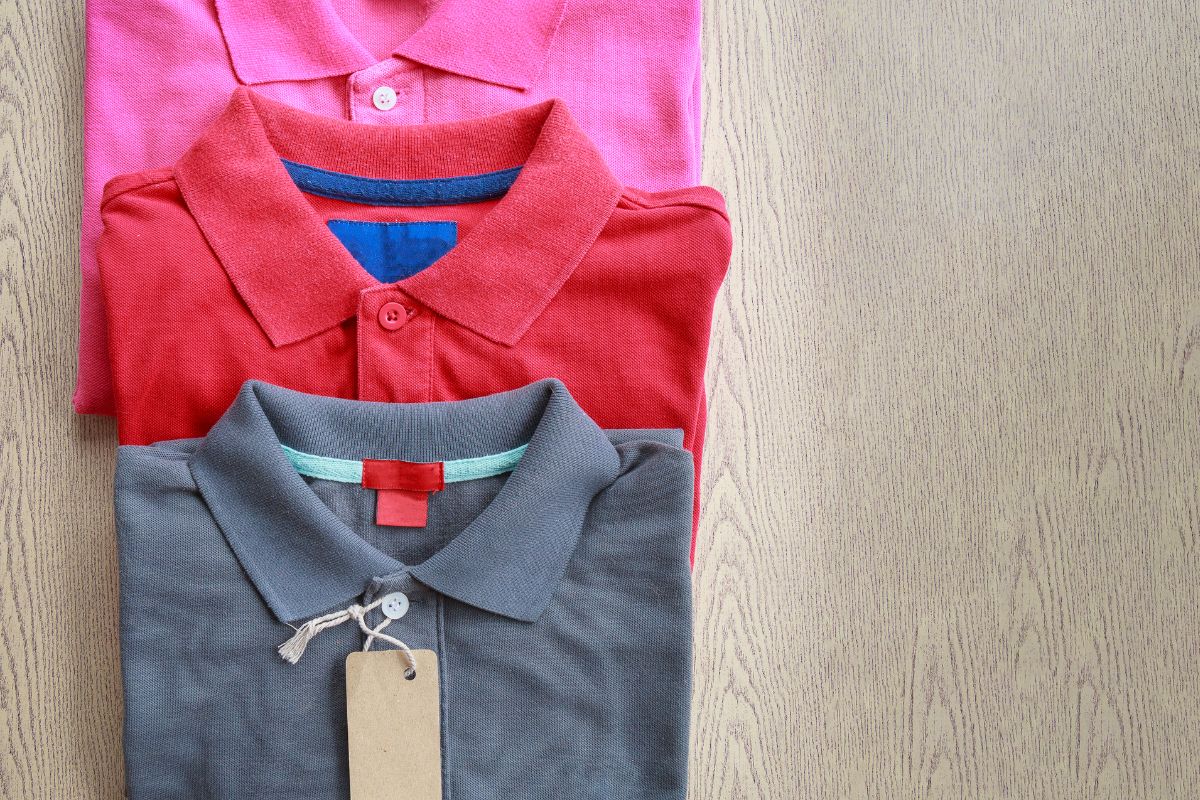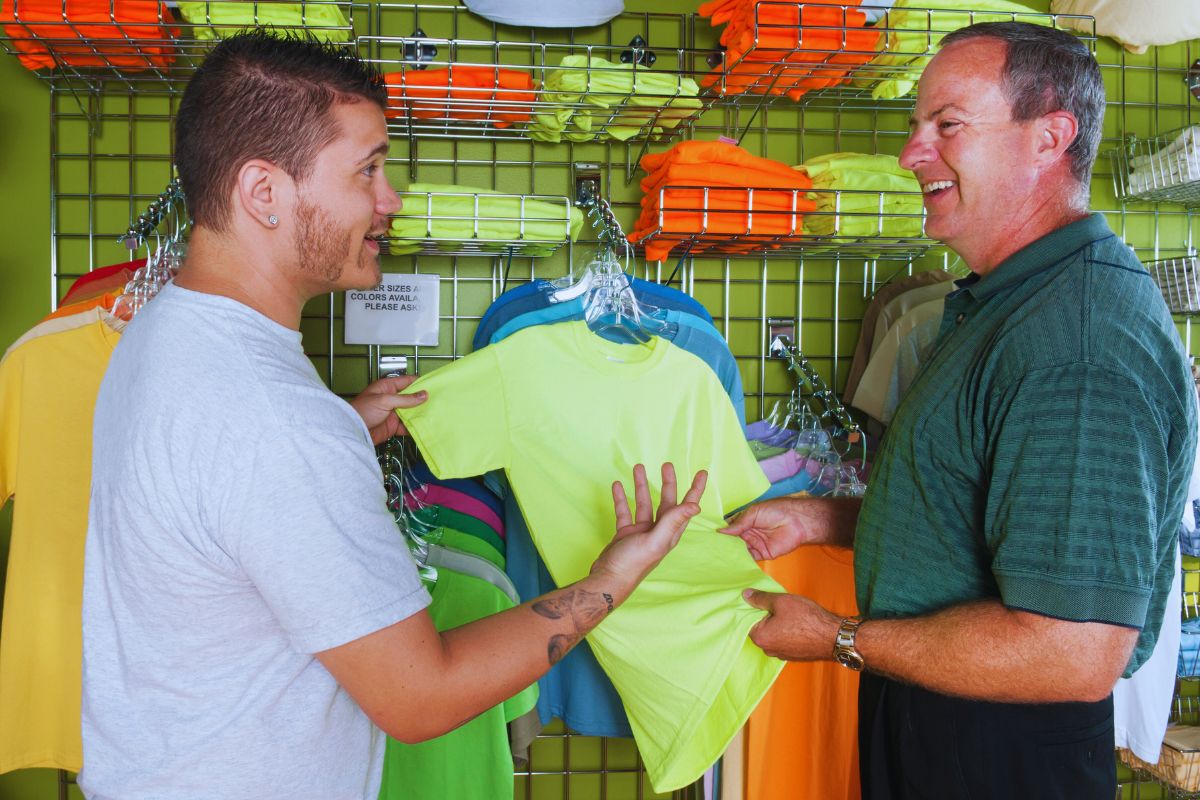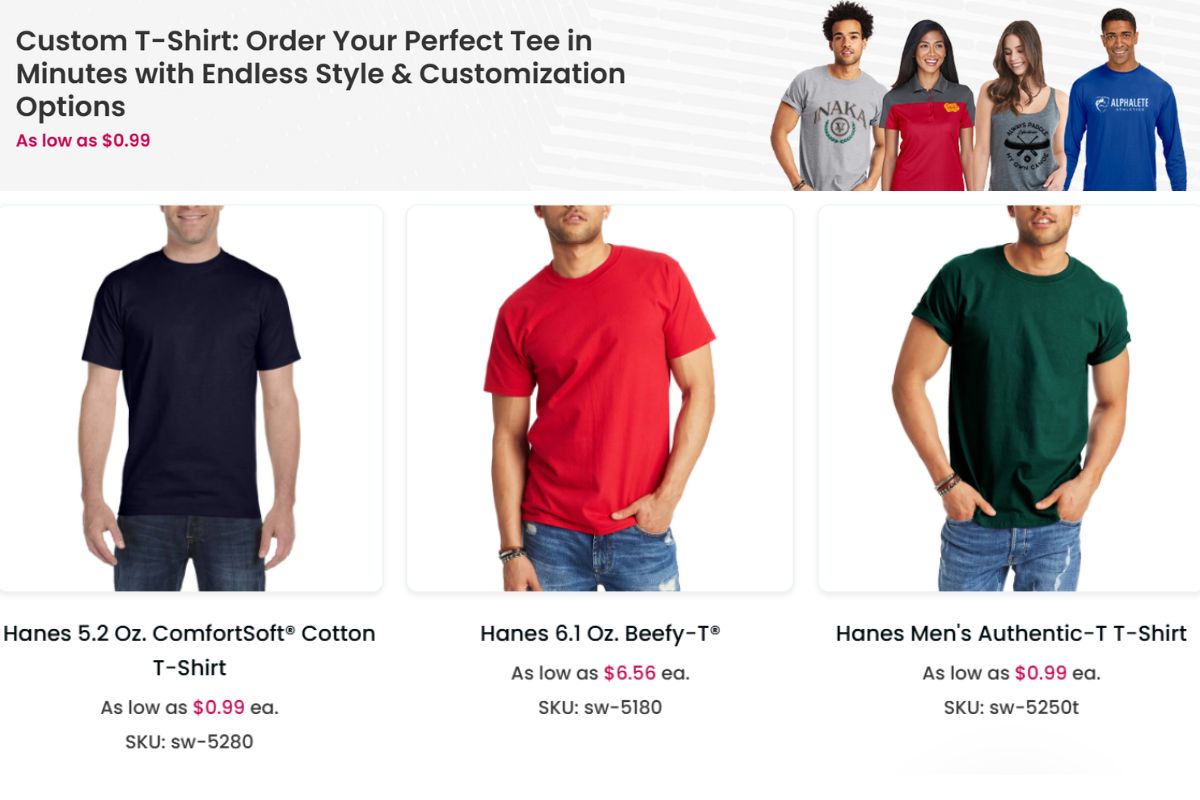To run a successful t-shirt business, understanding your profit margin is essential. Most sellers aim for a profit margin around 50%. This figure helps you set prices that not only cover costs but also generate a reasonable income.
Calculating your profit margin involves knowing your total costs, which can include production, printing, and shipping.
For instance, if your t-shirt costs $10 to make, selling it for $20 would meet that 50% margin target.
Table of Contents for Boosting T-Shirt Business Profits
- Understanding T-Shirt Business Profit Margins
- Cost Factors in T-Shirt Production
- Pricing Strategies for Maximum Profitability
- Sales Channels and Online Retail
- Print-On-Demand as a Business Model
- Shipping and Fulfillment Strategies
- Enhancing Customer Experience
- Marketing and Branding Essentials
- Calculating and Increasing Margins
- Frequently Asked Questions
- How much profit per t-shirt can one typically expect?
- What steps are involved in calculating profit margin for t-shirts?
- What constitutes a good profit margin on t-shirt sales?
- Is running a t-shirt printing business a profitable endeavor?
- What is the average markup applied when selling t-shirts?
- What are the typical startup costs associated with a t-shirt printing business?
With the right strategies, you can adjust your pricing and boost your profits.
Throughout this article, you will discover practical methods to calculate and increase your t-shirt profit margin effectively.
Understanding T-Shirt Business Profit Margins
Knowing how to measure profit margins in your t-shirt business is crucial. This includes understanding what profit margin is, why market research matters, and how to analyze your competitors effectively. These elements can significantly shape your pricing and sales strategies.
Defining Profit Margin in the T-Shirt Industry
Profit margin is a key metric that helps you evaluate your t-shirt business’s financial health. It shows the percentage of your total sales revenue that becomes your profit after costs.
Two main types to consider:
Gross Profit Margin: This represents the difference between your sales revenue and the cost of goods sold (COGS). It indicates how efficiently you produce and sell your t-shirts.
Net Profit Margin: This is your total profit after all expenses, including operating costs and taxes. It provides a clearer picture of how profitable your business really is.
An ideal target profit margin for t-shirt businesses often falls between 30% to 50%. This range can help you make informed decisions about pricing your shirts while staying competitive.
Importance of Market Research
Market research is vital for setting the right profit margin. It helps you understand customer preferences and trends in the t-shirt industry.
By investigating what your target market values, you can adjust your pricing strategy accordingly.
Consider these action points for effective market research:
Analyze Pricing: Look at how similar t-shirts are priced in your niche. This insight helps you decide if your desired profit margin is achievable.
Understand Demand: Knowing what styles and designs are popular allows you to tailor your products to meet customer needs.
Effective market research not only guides your pricing decisions but also enhances your ability to achieve the desired profit while remaining competitive.
Analyzing Competitors
To maximize your t-shirt business profit margin, you need to analyze your competitors. Understanding what they offer helps you identify gaps in the market and potential areas for improvement.
Focus on these aspects:
Pricing Strategies: Look at how competitors price similar products. This can help you determine if you can justify a higher price or need to adjust yours.
Product Quality: Assess the quality of their t-shirts. Ensuring your product stands out can allow you to command a higher price.
By closely analyzing competitors, you can find ways to improve your profit margins and position your t-shirt business for success.
Cost Factors in T-Shirt Production
| Product Type | Production Cost ($) | Selling Price ($) | Profit per Unit ($) | Profit Margin (%) | Bulk Discount Selling Price ($) (10+ Units) | Profit per Bulk Unit ($) |
|---|---|---|---|---|---|---|
| Basic Cotton Tee | $2.50 | $6.00 | $3.50 | 58.3% | $5.00 | $2.50 |
| Premium Cotton Tee | $4.00 | $10.00 | $6.00 | 60.0% | $8.50 | $4.50 |
| Graphic Print Tee | $4.50 | $12.00 | $7.50 | 62.5% | $10.00 | $5.50 |
| Organic Cotton Tee | $5.00 | $15.00 | $10.00 | 66.7% | $13.00 | $8.00 |
| Tie-Dye or Custom Tee | $6.00 | $18.00 | $12.00 | 66.7% | $16.00 | $10.00 |
| Hoodies & Sweatshirts | $10.00 | $30.00 | $20.00 | 66.7% | $27.00 | $17.00 |
| Long-Sleeve Tees | $5.50 | $16.00 | $10.50 | 65.6% | $14.00 | $8.50 |
| Tank Tops | $3.50 | $10.00 | $6.50 | 65.0% | $8.50 | $5.00 |
| Sweatpants | $8.00 | $25.00 | $17.00 | 68.0% | $22.00 | $14.00 |
| Leggings | $7.00 | $20.00 | $13.00 | 65.0% | $18.00 | $11.00 |
| Socks (Pair) | $2.00 | $6.00 | $4.00 | 66.7% | $5.00 | $3.00 |
| Caps & Hats | $3.00 | $12.00 | $9.00 | 75.0% | $10.00 | $7.00 |
| Beanies | $3.50 | $14.00 | $10.50 | 75.0% | $12.00 | $8.50 |
| Slippers | $5.00 | $18.00 | $13.00 | 72.2% | $16.00 | $11.00 |
When it comes to t-shirt production, understanding the costs involved is key to managing your profit margin. Different expenses play a role, from basic materials to additional fees that can affect your overall profitability. Let’s explore these critical factors in detail.
Calculating Production Costs
Production costs are the foundation of your t-shirt pricing. To calculate these, consider all materials used, such as fabric, ink, and other supplies.
For example, if your materials cost $10 per t-shirt and you produce 100 shirts, your basic production cost is $1,000.
You should also factor in labor costs, including the time taken to design, print, and package the t-shirts.
Be sure to keep track of any fluctuating costs. If your fabric supplier raises prices, it will impact your overall expenses. Regularly updating your cost calculations can provide better clarity on your profit margin.
Variable vs Fixed Costs
Costs can be broken down into variable and fixed categories.
Variable costs fluctuate with production volume. Examples include materials and shipping expenses. If you produce more shirts, your material costs will increase.
Fixed costs, on the other hand, remain consistent regardless of how many t-shirts you sell. These include rent, equipment, and salaries for permanent staff.
Knowing the balance between these costs can help you set prices effectively. By managing both types of costs, you can increase your profit margin over time.
Additional Expenses to Consider
In addition to production costs, keep an eye on other expenses that can affect your bottom line.
These may include marketing costs, which are essential for promoting your shirts.
Budgeting for social media ads or influencer partnerships can be vital for sales.
Don’t forget about transaction fees and other business expenses.
For example, if you sell online, platforms often take a percentage of sales. Shipping expenses can also add up, especially if you offer free shipping to attract customers.
All these factors combined play a significant role in your overall profit margin.
Pricing Strategies for Maximum Profitability

Setting the right price for your t-shirts is crucial for maximizing profit. Different pricing strategies can help you align your costs, value, and competition effectively. Here are some key methods to consider.
Developing a Pricing Strategy
To create an effective pricing strategy, start with a pricing formula.
A simple way to calculate your retail price is:
Retail Price = Cost + Desired Profit Margin
Identify your target market and understand what they value. Consider internal factors like your production costs and external elements such as competition.
This will guide your selling price to strike a balance between what customers are willing to pay and your profit goals.
Cost-Based Pricing Tactics
Cost-based pricing focuses on your costs to determine price.
Begin by calculating your total production costs, which include materials, labor, and overhead. Once you have this figure, add a markup to establish your sale price.
For example, if your total cost is $10 and you want a 50% markup:
- Sale Price = Total Cost x (1 + Markup)
- Sale Price = $10 x 1.5 = $15
This method is straightforward. However, ensure this price also covers other expenses like marketing and shipping.
Value-Based and Competitor-Based Pricing
Value-based pricing sets your price according to the perceived value to customers.
Understanding what features and benefits resonate most with your audience is vital.
For instance, if your t-shirts feature unique designs or high-quality materials, customers may accept higher prices.
Competitor-based pricing requires you to analyze similar t-shirts in the market. Price your products accordingly, either matching or positioning yourself above or below competitors.
This method emphasizes psychological pricing, which can impact customer behavior.
For example, pricing a t-shirt at $19.99 instead of $20 can make it seem more appealing.
Combining these approaches allows you to find a competitive edge while ensuring profitability.
Sales Channels and Online Retail
| Sales Channel | Platform Examples | Pros | Cons | Best For | Estimated Fees (%) |
|---|---|---|---|---|---|
| Your Own Website | Shopify, WooCommerce, Wix | Full control, branding, higher profits | Requires marketing & SEO efforts | Established brands, long-term growth | 2-5% (Payment processing) |
| Marketplaces | Amazon, eBay, Etsy | Large customer base, easy setup | High competition, seller fees | Beginners, casual sellers | 8-15% (Platform fees) |
| Print-on-Demand (POD) | Printful, Printify, Redbubble, Teespring | No inventory, automated fulfillment | Lower profit margins | Passive income, testing designs | 10-30% (Base cost + markup) |
| Social Media Shops | Instagram Shop, Facebook Marketplace | Direct engagement, low ad cost | Limited organic reach | Small brands, influencers | 0-5% (Processing fees) |
| Dropshipping | Spocket, Modalyst, AliExpress Dropshipping | No upfront costs, scalable | Reliant on suppliers | Entrepreneurs, testing niche products | 10-25% (Product cost + markup) |
| Retail & Pop-Up Stores | Local boutiques, malls, flea markets | Customer interaction, brand exposure | High overhead costs | Established brands, events | Variable (Rent + staffing) |
| Subscription Boxes | Cratejoy, Monthly T-shirt Clubs | Recurring revenue, loyal customers | Requires consistent marketing | Fan-based niche products | 10-20% (Fulfillment + fees) |
| Wholesale/B2B | Selling to stores, corporate orders | Bulk sales, steady revenue | Lower profit per unit | Bulk manufacturers, large retailers | 30-50% discount on retail price |
Choosing the right sales channels is crucial for maximizing your t-shirt business’s profit margins. You can sell t-shirts through dedicated online store platforms or popular marketplaces. Understanding both options helps you reach more customers and manage costs effectively.
Choosing the Right Online Store Platforms
When setting up your online store, platforms like Shopify and WooCommerce are popular choices.
Shopify offers an easy-to-use interface and various templates to get you started quickly. You can also find plenty of apps to boost your sales.
WooCommerce, on the other hand, is a plugin for WordPress. It’s great for those familiar with the platform and looking for more control over their store.
Consider your budget and technical skills. If you prefer a simple, guided setup, Shopify is ideal. If you want flexibility and customization, WooCommerce might be your best bet.
Leveraging Marketplaces for T-Shirt Selling
Marketplaces like Etsy, Society6, and Redbubble offer unique benefits.
These platforms have built-in audiences eager to buy custom t-shirts.
Etsy is excellent for handmade or vintage designs. You can reach niche markets here.
Society6 and Redbubble are perfect for artists, allowing you to sell t-shirts alongside prints and home decor.
Don’t overlook Merch by Amazon, which provides huge exposure and streamlined fulfillment.
Using these marketplaces can help you reach more customers without the need for extensive marketing efforts.
Print-On-Demand as a Business Model
Print-on-demand is a flexible business model that allows you to sell custom t-shirts without holding inventory. This setup minimizes risk and upfront costs. You only produce items when an order is placed, which can help you respond quickly to trends and customer demands.
Exploring Print-On-Demand Services
Print-on-demand services like Printify and Placeit provide the tools you need to start your t-shirt business.
These platforms handle printing and shipping, which gives you more time to focus on design and marketing.
To get started, you upload your artwork and select the products you want to sell. Here are some key benefits:
- No Inventory Costs: You avoid the expenses of unsold stock.
- Variety of Products: You can offer different styles, colors, and sizes to appeal to a broader audience.
- Scalability: Easily expand your product line with minimal effort as your order volume increases.
These elements make print-on-demand a practical choice for new entrepreneurs.
Integrating with Print-On-Demand Platforms
Integrating with print-on-demand platforms like Canva or others is essential for streamlining your t-shirt business.
These platforms simplify the design process and allow you to create visually appealing products quickly.
When setting up:
- Choose a Platform: Find one that fits your needs, considering fees and features.
- Connect to Storefronts: Many services integrate easily with e-commerce sites like Shopify and Etsy.
- Pricing Strategy: Set your prices based on production costs and desired profit margins.
For example, if your production cost is $10 and you want a 20% profit margin, set your selling price around $25.
This combination of design and sales integration helps maximize your t-shirt sales and profits.
Shipping and Fulfillment Strategies
| Strategy | How It Works | Pros | Cons | Best For | Estimated Cost |
|---|---|---|---|---|---|
| Self-Fulfillment | Store and ship products yourself using USPS, FedEx, or UPS. | Full control, higher profit margins | Time-consuming, packaging costs | Small businesses, handmade items | $3–$8 per package (varies by weight and destination) |
| Print-on-Demand (POD) Fulfillment | POD platforms like Printful, Printify, or Teespring print and ship for you. | No inventory needed, automated process | Lower profit margins, slower shipping | Beginners, testing new designs | $4–$15 (built into product cost) |
| Third-Party Logistics (3PL) | Use fulfillment services like ShipBob, Amazon FBA, or Deliverr to store and ship orders. | Faster shipping, bulk order discounts | Warehousing fees, setup costs | Growing brands, scaling businesses | $3–$10 per item + storage fees |
| Dropshipping | Supplier ships directly to customers. No inventory needed. | No upfront cost, easy scalability | Longer shipping times, quality control issues | Startups, low-budget sellers | $5–$20 (varies by supplier & location) |
| Local Delivery & Pickups | Offer local same-day delivery or in-store pickups. | Faster delivery, no shipping costs | Limited reach, requires local customers | Brick-and-mortar stores, local brands | Free or $1–$5 (delivery costs) |
| Flat-Rate Shipping | Charge a fixed shipping fee for all orders. | Simple pricing, predictable costs | Can be expensive for small orders | Stores with consistent order sizes | $5–$10 per order |
| Free Shipping (Built-in Cost) | Include shipping costs in product pricing. | Attracts more buyers, reduces cart abandonment | Higher product price may deter customers | Premium products, marketplaces like Etsy | Varies (depends on product markup) |
Effective shipping and fulfillment strategies directly impact your profit margins. You need to set clear shipping costs while considering customer expectations. Additionally, offering free shipping can enhance sales but requires careful planning.
Setting Shipping Costs and Policies
When setting shipping costs, calculate all related expenses, including packaging and delivery fees. This ensures you cover shipping expenses without hurting your profit margin.
Consider offering multiple shipping options. For example:
- Standard Shipping: Longer delivery time, lower cost.
- Expedited Shipping: Quicker delivery, higher price.
Clearly outline your shipping policies on your website. Customers appreciate transparency regarding estimated delivery times and any potential delays.
Using a flat-rate shipping model can simplify costs for you and your customers. It makes pricing straightforward and can encourage more sales, as buyers know what to expect.
Offering Free Shipping and Its Impact
Free shipping can be a powerful tool to boost sales. Many customers expect it, and research shows that it influences buying decisions.
To manage the costs of free shipping, consider these strategies:
- Incorporate Costs into Product Prices: Raise prices slightly to cover shipping.
- Set a Minimum Purchase Amount: Offer free shipping on orders over a certain threshold. This encourages larger purchases and balances your expenses.
Monitor your shipping expenses closely to see if offering free shipping affects your profit margin. Adjust your approach as needed to maintain profitability while satisfying customer expectations.
Enhancing Customer Experience

Improving customer experience is crucial for boosting your t-shirt business profit margins.
Focusing on product quality and effectively gathering feedback can set your brand apart and keep customers coming back.
Prioritizing Product Quality
The quality of your t-shirts directly affects customer satisfaction.
When selecting products, consider using popular shirts like the Gildan 5000, known for its durability and comfort.
Investing in high-quality materials ensures that your shirts feel good and last longer.
Unique designs also play a significant role in quality perception. Make sure your designs stand out and resonate with your target audience.
Whether it’s bold graphics or personalized prints, high-quality designs can entice customers to choose your products over competitors.
Don’t forget to monitor the production process closely. Quality control checks can help identify any issues before the shirts reach the customer.
This attention to detail can enhance the overall customer experience and increase repeat purchases.
Gathering and Implementing Customer Feedback
To tailor your offerings, actively seek customer feedback.
Implement surveys after purchases to gather insights about their experience. Ask specific questions about product quality, design preferences, and shipping efficiency.
Utilize feedback to improve your business continuously. If customers suggest you add more unique designs or customize t-shirts further, consider their requests.
This adaptability shows customers you value their opinions and care about their needs.
You can also create a community around your brand. Encourage customers to share their experiences on social media.
This not only builds brand loyalty but also provides insights into what your audience loves and wants.
Marketing and Branding Essentials
| Marketing Strategy | Description | Pros | Cons | Best For | Estimated Cost |
|---|---|---|---|---|---|
| Social Media Marketing | Promote products on Instagram, Facebook, TikTok, Pinterest, etc. | Builds brand awareness, engages audience directly | Time-consuming, requires creativity and consistency | Small brands, influencers, visual products | $0–$500/month (ads + tools) |
| Influencer Marketing | Partner with influencers to promote products via social platforms | High engagement, trusted recommendations | Can be costly, depends on influencer’s audience | Brands looking to expand reach | $50–$5,000+/campaign |
| Content Marketing (SEO) | Create blog posts, YouTube videos, and guides that rank on search engines | Long-term, organic traffic, builds trust | Time-intensive, requires SEO expertise | Brands with a long-term marketing strategy | $100–$1,000+/month (if outsourcing SEO) |
| Email Marketing | Send newsletters, promotions, and product updates to subscribers | Direct communication, high ROI | Needs a solid email list, can be seen as spam if not done right | Established brands with email lists | $20–$500/month (email tools) |
| Referral Programs | Offer discounts or rewards for customers who refer others | Encourages word-of-mouth marketing | Requires a customer base to be effective | Startups, loyal customers | $0–$500+ (depends on the reward system) |
| Paid Ads (PPC) | Run Google Ads, Facebook Ads, or Instagram Ads | Quick results, highly targeted audience | Can be expensive, requires continuous monitoring | Brands looking to scale quickly | $100–$2,000+/month |
| Collaborations & Partnerships | Partner with other brands or local businesses for co-promotions | Expands audience, shared costs | Needs alignment of brand values | Small businesses, local collaborations | $0–$500+ (negotiable based on collaboration) |
| Pop-Up Shops & Events | Host in-person events or collaborate in pop-up markets | Builds local awareness, direct customer interaction | High upfront costs, limited reach | Local brands, new product launches | $200–$2,000+ (venue + materials) |
| Affiliate Marketing | Allow bloggers, influencers, and others to promote products for a commission | Scalable, pay-per-performance | Needs an established affiliate network | Larger brands, niche markets | 5–30% commission per sale |
| Brand Storytelling | Share your brand’s story and values through content, ads, and packaging | Builds emotional connection, long-lasting brand loyalty | Requires consistency and authenticity | Premium and sustainable brands | $0–$500+ (creative + content) |
To succeed in the t-shirt business, you must focus on identifying your target audience and effectively managing your marketing budget. These elements are crucial for establishing a strong brand and maximizing your profit margins.
Target Audience and Brand Positioning
Identifying your target audience is essential for effective marketing. This group consists of customers who resonate with your product’s style, message, and price point.
- Demographics: Consider age, gender, income, and location.
- Interests: Align your designs with the interests and values of your audience.
- Behavior: Analyze purchasing habits and preferences.
Once you know your audience, position your brand distinctly in the market. This means defining what makes your t-shirts unique.
A clear brand message can attract loyal customers and inspire word-of-mouth marketing.
You might position your brand as eco-friendly, casual, or trendy, depending on your target audience’s values and tastes.
Effective Marketing Costs Allocation
Proper allocation of your marketing budget is vital for growth. Here’s a simple breakdown:
- Social Media Advertising: Allocate around 40% of your budget here. Platforms like Instagram and Facebook are perfect for visual products and reaching younger audiences.
- Influencer Collaborations: Set aside 30% for partnerships. Influencers can significantly enhance brand visibility.
- Email Marketing: Use 20% for targeted campaigns. This keeps existing customers engaged and encourages repeat purchases.
- Traditional Advertising: Use the remaining 10% for local flyers or events. This can increase brand presence in your community.
By clearly defining and allocating your costs, you ensure that every dollar spent contributes to your brand’s growth and increases your profit margins.
Calculating and Increasing Margins

Knowing how to calculate your profit margins is essential for any t-shirt business. You can also find ways to optimize these margins, which can lead to better financial health and growth for your shop.
Using Profit Margin Calculators
Profit margin calculators are useful tools for t-shirt businesses. They allow you to input key data, such as selling price, cost of goods sold (COGS), and operating expenses.
Steps to Use a Profit Margin Calculator:
- Input Selling Price: Enter the final price at which you sell your t-shirt.
- Enter COGS: Input the total cost of producing the t-shirt, including materials and labor.
- Add Operating Expenses: Include additional costs like shipping and marketing.
The calculator will then show your profit margin percentage. This helps you understand the potential profits from each sale and assess if your prices need adjustment.
Optimizing Profit Margins
To increase your profit margins, focus on costs and pricing strategies. You can work on several areas:
- Reduce Production Costs: Look for suppliers with lower prices for materials without sacrificing quality.
- Adjust Pricing: If your product is unique or high-quality, consider raising prices. Test different price points to find the optimal balance.
- Offer Bundles or Discounts: Encourage larger purchases by suggesting bundle deals.
Keep track of your gross profit, which is the difference between sales and production costs. This will show you the health of your business and help you make informed decisions.
By applying these strategies, you can enhance your t-shirt profit margins effectively.
Frequently Asked Questions
This section answers common questions about t-shirt profit margins, pricing strategies, and the initial costs associated with starting a t-shirt printing business. Understanding these aspects can help you make informed decisions and improve your business’s financial health.
How much profit per t-shirt can one typically expect?
You can expect a profit margin of about 30% to 50% for each t-shirt, depending on your pricing and production costs. For example, if your t-shirt costs $10 to produce, you might sell it for $15 to $20, earning a profit of $5 to $10 per shirt.
What steps are involved in calculating profit margin for t-shirts?
To calculate profit margin, subtract total production costs from the selling price. Then, divide the profit by the selling price and multiply by 100 to get the percentage. For example, if you sell a t-shirt for $20 and it costs $10, your profit is $10, giving you a 50% profit margin.
What constitutes a good profit margin on t-shirt sales?
A good profit margin for t-shirt sales is typically between 30% and 50%. Margins below 30% may indicate that you need to adjust your pricing or reduce costs. Margins above 50% can be good, but ensure they align with market expectations and customer willingness to pay.
Is running a t-shirt printing business a profitable endeavor?
Yes, a t-shirt printing business can be profitable if managed well. Factors like your target market, effective marketing, and cost control play a critical role in determining your success. Many entrepreneurs have found success by finding a niche and offering unique designs.
What is the average markup applied when selling t-shirts?
The average markup for selling t-shirts ranges from 100% to 300%. This means if a t-shirt costs $10 to produce, you might sell it for $20 to $40. The markup can vary based on brand strategy and market demand.
What are the typical startup costs associated with a t-shirt printing business?
Startup costs can vary. Typical expenses include equipment, inventory, website development, and marketing.
Initial costs may range from a few hundred to several thousand dollars. This depends on your business scale and production method.




